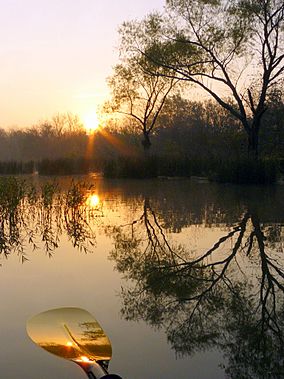Deep Fork National Wildlife Refuge facts for kids
Quick facts for kids Deep Fork National Wildlife Refuge |
|
|---|---|
|
IUCN Category IV (Habitat/Species Management Area)
|
|

Kayaking in the Deep Fork Wildlife Refuge at sunrise
|
|
| Location | Okmulgee County, Oklahoma, United States |
| Nearest city | Okmulgee, Oklahoma |
| Area | 9,748.28 acres (39.4499 km2) |
| Established | 1993 |
| Visitors | 45,000 per year |
| Governing body | U.S. Fish and Wildlife Service |
| Website | Deep Fork National Wildlife Refuge |
The Deep Fork National Wildlife Refuge (DFNWR) is a special natural area in eastern Oklahoma. It is part of the United States system of National Wildlife Refuges. This refuge is very important for many kinds of wild birds. They use it as a resting and feeding spot during their long flights in spring and fall.
The refuge is located near the city of Okmulgee. It stretches for about 20 miles (32 kilometers) along both sides of the Deep Fork River. Each year, about 45,000 people visit this amazing wildlife area.
Contents
About the Refuge
The Deep Fork National Wildlife Refuge was officially created in June 1993. It was dedicated in February 1995. The refuge covers a large area of land. In 2015, about 9,748 acres (39.45 square kilometers) were publicly owned. The plan is to buy more land over time until the refuge reaches its full planned size.
What the Refuge Looks Like
The refuge is a long, narrow strip of land. It has many different types of natural areas. You can find wetlands, which are soggy areas, and oxbow lakes. These lakes are shaped like a U or C and form when a river changes its path. There are also swamps and forests on higher ground.
The Deep Fork River winds its way through the refuge. More than 80 percent of the refuge gets flooded every year. This flooding creates a perfect home for many water birds and other animals.
Animals You Might See
Many different animals live here. You can spot white-tailed deer and majestic bald eagles. Wild turkeys also make their home in the refuge.
Scientists have recorded 254 different types of birds here. There are also 51 kinds of mammals. Some special animals that live here include the river otter and the alligator snapping turtle. You might even see a northern scarlet snake. Beavers are very common in the refuge.
Trees and Plants
Most of the refuge is covered by forests. These are called bottomland forests because they are in low-lying areas that often flood. You can find many kinds of trees here. These include oak, pecan, elm, hickory, and ash. There are also sugarberry, walnut, riverbirch, and willow trees.
Much of the forest was cut down in the past. So, most of the trees you see today are still quite young. However, there are a few older, more mature forest areas. When the floods come, new hardwood trees start to grow near the river. Then, they spread out into other parts of the refuge.
Fun Things to Do
Most of the Deep Fork National Wildlife Refuge is open to visitors all year. There are several parking areas. From these spots, you can easily get into the refuge. It's a great place for many outdoor activities.
Activities to Enjoy
- Bird Watching: With so many bird species, it's a fantastic spot for bird watchers.
- Hunting: You can hunt deer, rabbits, squirrel, turkey, and ducks during certain seasons.
- Fishing: The Deep Fork River is known for large Flathead catfish. You can also catch other types of fish. There's a special fishing area at Montezuma Creek.
- Hiking: There are about 25 miles (40 kilometers) of trails and unpaved roads. These are great for walking and exploring.
- Boating: Kayaking is a very popular activity on the Deep Fork River.
Special Trails
Near the refuge headquarters, you can walk on the Cussetah Bottoms Boardwalk. This boardwalk is about half a mile long. It takes you through forests, swamps, and past beaver ponds. In the southern part of the refuge, there's another trail. It follows an old railroad track. This means it's raised above the ground, so it stays dry even when the land floods.
Remember, off-road vehicles are not allowed in the refuge.
Nearby Natural Areas
The Deep Fork National Wildlife Refuge is part of a larger network of protected lands.
- To the north, it connects with the Okmulgee Wildlife Management Area (OWMA). This area is about 10,900 acres (44.1 square kilometers). The Deep Fork River flows for 6 miles (9.7 kilometers) through the OWMA. This area is mostly hilly, unlike the flat, swampy refuge.
- To the south, the refuge connects with the Eufaula Wildlife Management Area. This area protects another 7 miles (11 kilometers) of the Deep Fork River. It goes all the way to where the river meets Eufaula Lake. The land here is similar to the refuge.
Together, these three areas protect more than 25,000 acres (101 square kilometers) of land. They also preserve about 30 miles (48 kilometers) of the Deep Fork River in a nearly natural state.
Images for kids




